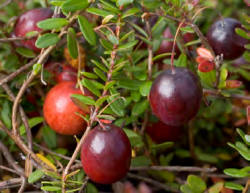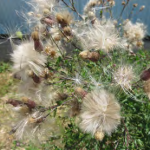Avoiding Herbicide-Resistant Weeds in Cranberries (2015)
Avoiding Herbicide-Resistant Weeds in Cranberries
 Herbicide resistant weeds have not been as high on the radar for cranberry growers as they have been for row crop producers in recent years, but resistant weeds still can pose a significant risk. While most cranberry production regions are isolated from grain crops — such as field corn and soybean where resistant weeds are all too common — the lack of crop rotation, a limited arsenal of control tools and weeds (including perennials) that produce abundant seed increase the risk of selecting for herbicide resistance in the cranberry system.
Herbicide resistant weeds have not been as high on the radar for cranberry growers as they have been for row crop producers in recent years, but resistant weeds still can pose a significant risk. While most cranberry production regions are isolated from grain crops — such as field corn and soybean where resistant weeds are all too common — the lack of crop rotation, a limited arsenal of control tools and weeds (including perennials) that produce abundant seed increase the risk of selecting for herbicide resistance in the cranberry system.
Why are resistant weeds a concern in cranberry production?
- Cranberry production relies on just a few herbicide sites of action for the vast majority of weed control. An herbicide’s site of action describes where it works in the plant, such as by blocking a particular enzyme. While agronomic row crop producers may be able to choose from a suite of herbicides with up to 18 different sites of action, commonly used cranberry herbicides represent only 8 different sites of action (Table 1).
- Herbicides are often applied individually in cranberries because of applica-tion timing restrictions (for example, dormant pre-bud break applications vs. in-season post-emergent applications), crop safety issues when tank-mixing (surfactant incompatibility between herbicides) and herbicide label re-strictions. This increases the selection pressure during individual herbicide applications on a single-site herbicide to maintain its ability to prevent weed seed production.
- The allowable rate range is fairly broad for several of the cranberry herbicides. The use of a sub-lethal herbicide dose can increase the resistance selection pressure as these weeds often recover to produce viable seed.
- Annual crop producers can use crop rotation to not only diversify herbicide sites of action across years but also to expand non-herbicide weed control options, such as cultivation. Cranberry producers do not enjoy these cultural options.
- While perennial weeds often reproduce vegetatively (for example, through below-ground runners), many of them are also prolific seed producers (gold-enrods). Annual and biennial weeds in cranberries also produce abundant seeds. The selection for herbicide resistance and the spread of resistant weeds commonly occurs through seed production. Additionally, several weeds in cranberries have special adaptations that allow seed to travel long distances: the “pontoons” that float curly dock seed in water, the wind-blown seed of Canada thistle and prolific small dodder seeds that spread among beds when flooding.
- Weed resistance to several of the herbicide sites of action used in cranberry production has already been observed in other crops and production regions (Table 1). It can happen, even in a diversified crop rotation! In some cases, in-dividual weeds are resistant to several sites of action, greatly limiting control options. Resistant weeds are a one-way trip — when they become resistant to an herbicide, they will not return to herbicide sensitivity.
- New herbicide options in specialty crops like cranberries are few and far be-tween, so we need to maximize and extend the effectiveness of our current tools so that they remain useful.
| CHART KEY | |
| Site of action number | Site of action name |
| Active ingredient (example) | Susceptibility; # of resistant species |
| Group 1 | ACCase inhibitors |
| sethoxydim (Poast) | High; 17 |
| clethodim (Select, Select Max) | High; 15 |
| Group 2 | ALS inhibitors |
| chlorimuron (Curio2) | High; 16 |
| Group 4 | Synthetic auxins |
| clopyralid (Stinger3) | Low; 1 |
| quinclorac (QuinStar 4L) | Moderate; 5 |
| 2,4-D | High; 16 |
| Group 9 | EPSP synthase inhibitors |
| glyphosate (Roundup) | High; 31 |
| Group 12 | Carotenoid biosynthesis inhibitors |
| norflurazon (Evital 5G) | Low; 0 |
| Group 15 | Long chain fatty acid inhibitors |
| napropamide (Devrinol) | Low; 0 |
| Group 20 | Cellulose inhibitors |
| dichlobenil (Casoron 4G) | Low; 0 |
| Group 27 | HPPD inhibitors |
| mesotrione (Callisto) | Moderate; 2 |
1 Weed Science Society of America (WSSA) herbicide mode of action group numbers. 2 Available through a special time-limited label in Oregon and Washington only. 3 Available through a special time-limited label in several states and with various trade names.
How does resistance happen?
Herbicides themselves are not likely to cause resistance within a plant. The repeat-ed exposure of plants to an herbicide site of action selects for individuals within the population that differ genetically so that they survive the herbicide application and reproduce. The selected survivor plants produce seed and the proportion of resist-ant plants increases among the overall population over time. Repeated exposure to the same site of action further selects for higher levels of resistance among the survivor population and the cycle continues. The result is a resistant plant popula-tion with the inherited ability to survive an herbicide application to which previous or other populations of the same species had been susceptible.
Steps to avoid herbicide-resistant weeds in cranberries
- Monitor for weeds that escape control. Keep records of new, problematic and expanding weed populations. The key to successful management is to identify new resistant populations early when they can still be eradicated, but oftentimes, they go unnoticed until the problem is out of control. Keep in mind that a resistant weed will not become susceptible again. Ask yourself a few key questions:
- Is the weed of concern normally controlled by the herbicide in question?
- Are there any application factors — a sprayer skip or miscalculated herbicide rate — that could account for the lack of control?
- Are there dead or symptomatic weeds of a different species nearby the weed of concern?
- Have you had to increase the rate of the suspect herbicide over time in order to get control?
- Rotate herbicide sites of action, not only within a growing season but also across years. This requires careful record keeping and an awareness of the site of action numbers included in Table 1 and on most herbicide labels. Pay particular attention to the herbicide sites of action where resistance has been more commonly observed: the ACCase inhibitors (sethoxydim and clethodim), EPSP synthase inhibitors (glyphosate) and ALS inhibitors (chlori-muron).
- Guard against contaminated crop inputs that can spread resistant weeds. Consider all sources — seed planted along roadways and dikes; new cranber-ry vines when renovating, equipment brought on the farm; and sand/water sources. Unfortunately, people are historically one of the greatest weed dispersal mechanisms!
- Eliminate survivors. Resistant weed populations spread through seed production, so efforts like hand-pulling and wick-wiping that prevent vi-able weed seed production can greatly reduce risk. These efforts may be time-consuming, but the alternative will be much more troublesome and long-term. For example, in some areas where weeds are resistant to multiple herbicide sites of action, growers have had to rely heavily on hand-pulling and removing problematic weeds from fields. Also, be sure to use herbicide rates within the labeled range and timing that will kill weeds and prevent seed production.
- Ask for help. If you suspect herbicide resistance on your farm, contact your extension agent and other specialists to help verify resistance. Also notify neighboring growers so they can take preventative action.
December 2015


